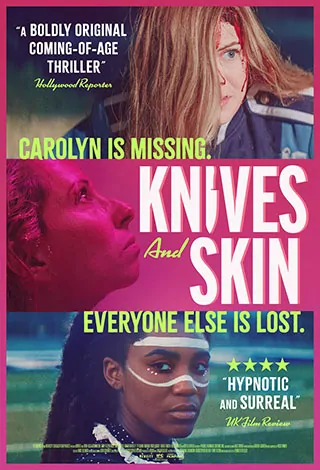| Carolyn Harper (Raven Whitley “Hala”) has gone missing. What happened to Carolyn Harper and who she is quickly become secondary to the impact of her disappearance on the community. This includes a group soul-searching teen girls. Joanna (Grace Smith from “Dorm Therapy”) and her friends Laurel (Kayla Carter, “I Hate LA”, and Charlotte (Ireon Roch, “Princess Cyd”) are struggling with life. However, they also recognize that there is hope in sight, as the outside world is visible on the roof of their school. Jennifer Reeder establishes an ethereal, dreamy aesthetic with neon pinks and violets that are reminiscent of Daniel Goldharber’s “Cam” and Nicolas Winding-Refn’s ” the Neon Demon.” We (like the residents of the town) then slowly slip into the deeply hypnotic charm of knives and skin. The film’s minor plots revolve around an enigmatic blonde girl in high school. This is reminiscent of David Lynch’s “Twin Peaks” where the disappearance Laura Palmer held audiences in a similar trance. The recent incident is the cherry on top for the large cast of characters who are all affected by a malaise that hovers over the entire place. The level of interaction we see is not enough to fill the emptiness that is created throughout the film. We know from the start that everything beyond will be more of the same. This feeling of repetition should not be interpreted as a negative, as the cyclical nature is integral to the film’s goal; it is a dramatization that is a continuous dream where beginning and ending are inseparable. It is evident that the notion of dreaminess, whether good or bad, is reflected in the constant theme of disconnection between parents and children, husbands and wives and even teenage friends. Any dialogue that resembles a bullet-point-style series of self-reflective thoughts rather than a socially engaging discussion. Regular use of songs reinforces the idea that we are not really watching anything. This is done on two levels. The first is sensory. The acapalla songs performed by the cast, while stoic, have an ethereal feel. Dreaminess is then imposed upon us through the use of song and music. Second, while the use of music can help us feel like we’re in a different world, it can also do the opposite by reminding us that we’re watching a movie. It can take us away from the dialogue scenes and prevent us from fully immersing ourselves in the experience. This is achieved by presenting fragments of different disconnected stories. It evokes a similar sense of detached feeling that we often experience after multiple dreams which are disassociated. In Wes Craven’s 1984 film “A Nightmare On Elm Street”, Nancy Thompson was required to take on this role, and care for her mother. This is another film that challenges our perception of reality and dreams. Nancy Thompson is shown caring for her divorced mother, a woman who has been struggling with alcoholism, and has been hiding a dark secret from her family. This is just before the final nightmare. Reeder shows us Joanna in Knives & Skin. She is a girl who looks similar to Nancy and who bathes her mother who has depression and agoraphobia. As if to confirm the interpretation of the film, the tiger’s face on her shirt comes to life and speaks to her in an effort to encourage her. This could be a representation of her own realisation, which was only possible because of a combination of recent events. The discovery of Carolyn’s body, however, is what shakes the community out of its self-serving, dreamy existence and awakens it to a sharper sense of reality. Joanna’s father, who lives in a van on the driveway to the family house, tells her that he feels “invisible”. He wears a clown mask and pretends to be a working performer throughout the film. Once Carolyn is discovered, he takes off the make-up to end an affair with his neighbor. The mask is removed and he can now move on. After three girls bring her home-cooked food, Mrs. Harper (Marika Englehardt from “House of Purgatory”) asks them if they’re okay. She then accuses them of lying. They all agree. The girls are left feeling hopeless, and Mrs. Harper reciprocates by saying that she doesn’t know “what the fuck” I am doing. In Knives & Skin there are themes that include disconnect, dysfunctionalism, and how the youth is more insightful than adults. One of the students demonstrates this point when he leads Mrs. Harper to her blindness after she asks to try on a mascot-style Beaver head. Reeder, a woman of creative talent who is drawn to exploring the female experience in her work, deals with social anxiety and depression as well as damaging attitudes towards body image. She does so with a welcome fearlessness. The performances are consistently good and the neon and sometimes absurd dialogue give the impression that we are watching something fantastical, rather than realism. Joanna pleads with her friend on the roof of the school, “Don’t you jump! You’ll cause a mess. It’s already a mess here.” Ironically, it turns out that he’s looking for a different way out. He finds comfort in the road that leads out of town. But the message of the girls is to keep going. | |





